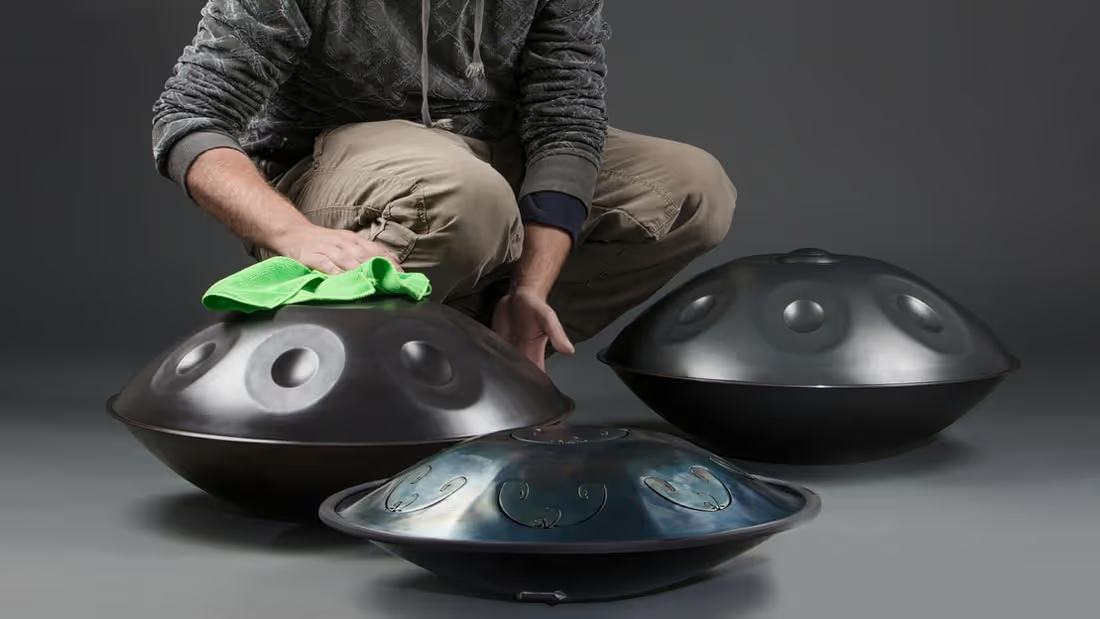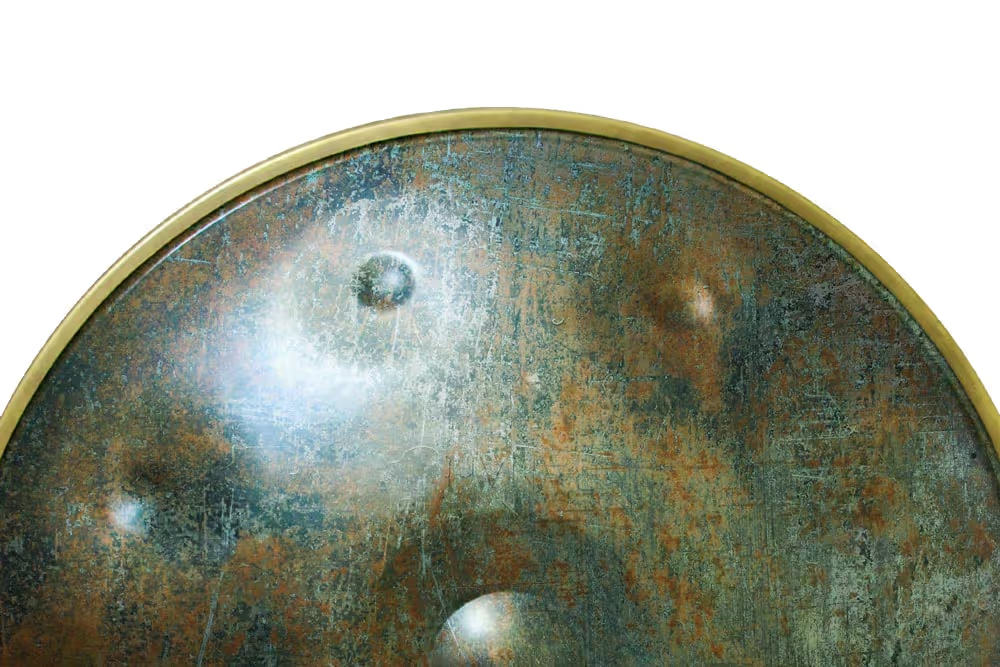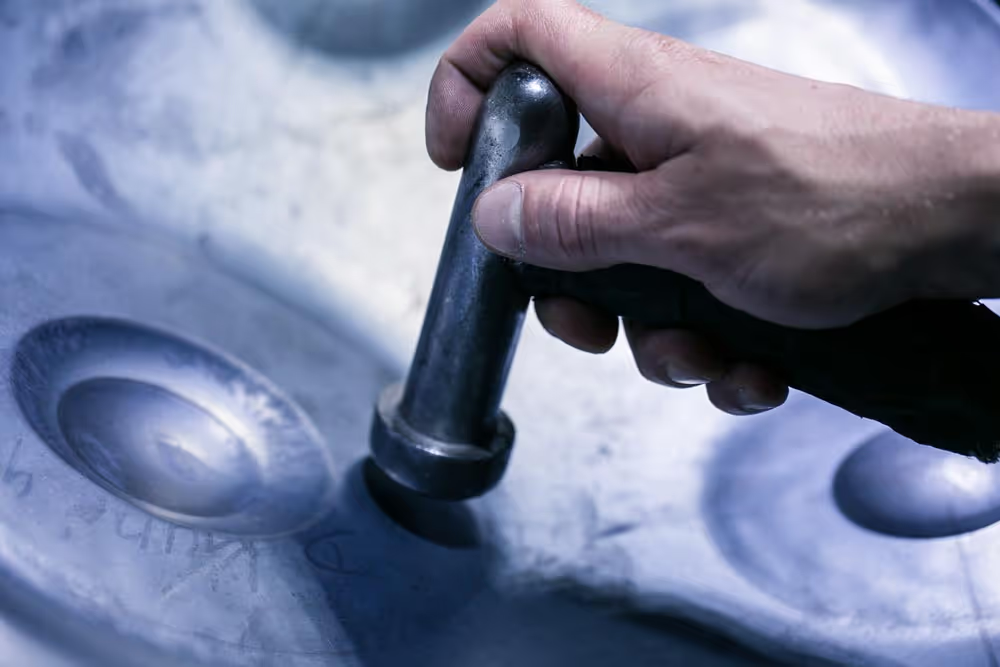You want to buy a handpan, but you feel lost? This is the guide you need to make the best decision for your future purchase.
In 2001, everything was much simpler. There was only one type of instrument, the Hang® from PANArt. You just had to go to visit them, try the instruments, and you could either buy it and go back home with it or place an order. Over the years that followed, it became increasingly difficult to get an instrument. As awareness of the Hang® grew, demand for them increased exponentially, and PANArt quickly became unable to meet everyone’s requests.
In 2013, PANArt stopped making instruments, and while there were several alternative makers who had started creating instruments, their waiting lists were long, due to pent up demand. During this time, it was not uncommon to wait between one and three years to get a handpan, especially if you had no connection to the handpan world.
Today, incredibly, we can find makers of handpans all over the world! The instrument is widely known and far more accessible. It is often possible to acquire a handpan in a very short period of time. This abundance presents a new problem. We now have a hard time figuring out how many manufacturers there are on the market, who they are, and what quality of work they produce.
More and more, I’m seeing the question 'What do I need to know in order to buy a handpan?'
Here are some tips to help you make the right decision :
1. What is the price of a handpan?
A handpan is not that expensive for a handmade instrument, but they are far from cheap. The price of 90% of handpans ranges between $1,500 and $3,000 USD. The big problem, however, is that the instrument is so sought after that some see it as an opportunity to make money. That’s why you will find manufacturers that sell instruments that are too expensive compared to the quality they offer, or people reselling instruments for far more than they originally acquired them for.
In other words, quality is not always proportionate to price. You will therefore find superb instruments for $1,500 USD and some poor-quality instruments for $3,000 USD or more.
But, do not be afraid! Your ear, with a little bit of practice, will help you make the right decision.
There is a ‘normal’ range pricing and I’ve written an article about how much a handpan cost, so you do not need to be an expert to know which instrument to buy.
2. How do I choose my handpan?
This is a huge question, and there is no simple or easy answer. But do not worry… with a few considerations and some research, you can make the decision that is right for you. Here are my top five tips to help you on your way.
- Trust your ears: Listen to as many handpan videos and performances as you can.
- Trust your head: What makes a good handpan? It’s all about sound quality. Check my list of what to look out for below.
- Trust your fingers: If possible, it’s always better to try before you buy. Here’s how to go about it.
- Trust your needs: When it comes to picking a scale, there are so many to choose from! You can do several things to narrow down the field. Below are some pointers.
- Trust your instincts: Ultimately, if it’s too good to be true, it probably is. Here you’ll find some tips to avoid the pitfalls.
Let me explain each of these points in more detail:
- Trust your ears: Search for handpan videos on YouTube (by typing “handpan”) and navigate from link to link to listen to many different videos. Put on a headset to help you pick up the subtleties of each instrument: tone, sustain, tuning, balance between notes, dynamics of instrument etc. (see point (ii) below for more) Make a note of the differences between each instrument that you hear.
This will help you to sharpen up your ears. Once you get ‘tuned in’ to listening, you will find the one(s) that sing to you.
The more videos you watch, the quicker you’ll be able to hear the difference between instruments that sound like saucepans and those of top quality.
The number of views/likes of a video can also be an indicator of the quality of an instrument. Be cautious, however, as the video may be popular due to some gimmick (someone who plays in the water or who beats the instrument overly hard).
- Trust your head: Before you buy, it really is worth doing your research to establish what makes a handpan good. For me, the 7 marks of a quality handpan are:
- Tuning
- Timber
- Sustain
- Balance
- An absence of cross-talk
- Dynamic Range
- Harmonics precision
If all these concepts seems a little vague to you, I have listed 7 marks of a quality handpan that will really guide that will really help you along the way, so check it out. If your handpan has all this, then you have a bomb!
- Trust your fingers: Ideally, you should always try before you buy. Visit festivals, ask handpan friends, put a call-out on forums for local players and/or contact reputable makers to see if you can arrange a visit. A good handpan should be easier to play and make sense of, even as a beginner. Take your time, have fun with it and explore it, keeping in mind the above list of qualities to look and listen out for.
- Trust your needs: The range of handpan scales out there is huge. The names may all sound foreign to you and it can feel complicated and overwhelming.
First you need to establish your preferences. Go back to YouTube. In addition to listening to the quality of the instruments, listen to the different scales, and write down those you like the most.
You may prefer different minor of major scales, the serious or the acute, the mellow or the upbeat, bassy or bright, oriental, jazzy, bluesy, celtic, etc. Which ones sing to you? You will normally find in the video description or in the video title itself the name of the scale and/or its notes. Don’t forget to make a list of all the ones that you like.
To narrow down this list, ask yourself: What do you want this handpan for? Is it for jams with others, compositions, to relax you after work, to add flavour to your current instrument set-up? Your handpan should work for you and your life, so your answer(s) here will help you to cut down to the best options.
Once you’ve made your choice, write down as much information as possible so you can effectively communicate your needs to the handpan maker on the day you place your order.
If you want to go deeper into the vast subject of scales, don't miss this complete guide to help you choose the scale of your handpan.
It is important to note that makers, for reasons too varied detail in this article, are not all willing to produce every scale. Ask them if they will make your preferred scale, and be prepared to either select from the manufacturer’s available list or choose an alternative maker.
- Trust your instincts: Ultimately, your ‘gut’ or instinct is your best friend.
If the price is too good to be true, if it’s only available to buy with no protection/guarantee, if the maker has a bad reputation... don’t be tempted. Again, it’s worth reading my 11 top tips to avoid getting scammed when you buy.
If a note or two sound ‘off’, if it’s disappointing in reality compared to the video, or if it simply doesn’t feel right when you play it, walk away.
Conversely, if you are obsessed with one particular YouTube video, if you get goosebumps from your visit to a certain workshop, if you cannot stop listening to that hijaz beauty at your local festival, then it’s a good sign. Before you commit, give yourself a cooling off period to see if the feeling lasts - it’s to get carried away on the spot!
With all the knowledge and preparation behind you, you can now confidently pick the one that makes your heart sing.
3. How to choose the right handpan material?
There are effectively 4 different handpan materials, all with their own benefits.
- 'Raw steel' handpan
Pros: Untreated, so generally the most cost-effective.
Cons: Prone to rust, so need the most care/maintenance. Not the best choice for those who live in humid areas or near the ocean. Also susceptible to stability/tuning issues over time. - 'Steel-coated' handpan
Pros: Weigh less than others, so easier to handle and travel with. Also cost-effective.
Cons: Susceptible to rust if surface is damaged. Generally less responsive and lacking dynamic range. - 'Nitrided steel' handpan (the material of the original Hang®, and still the most popular choice).
Pros: Treated, so rust resistant. Less sustain so better for percussive players.
Cons:, They still require maintenance/rust prevention treatment. Not the best choice for those who play slowly/melodically. - 'Stainless steel' handpan
Pros: Exceptionally rust resistant (including surface damage) so little-to-no maintenance. They have the longest sustain so great for melodic, slower players.
Cons: Harder to work with, so can vary in quality/stability, depending on the maker. Generally more expensive to buy. With long sustain, not the best choice for fast, percussive players. - 'Ember steel' handpan
Ember Steel is a type of stainless steel.
Ultimately, it’s all down to personal preference. The best material for you depends on what kind of player you are (ie slower/melodic or faster/percussive), the environment you live in and whether or not you want to spend time on maintenance and care. There is currently much discussion in the community about the benefits of stainless steel versus nitrided steel, with fierce advocates on both sides.
By the way, if you're interested about the science behind handpans, checkout my article on How are handpans made and why they sound so amazing and unique.
To find out which steel might be right for you, read my articles :
4. How to choose the size of my handpan?
The size of your handpan is quite important. At least in terms of comfort, range and ease of play. Before you buy, it’s worth considering the following:
- Number of notes. While there is no difference in quality of sound between larger and smaller instruments, if you’re looking for more notes, bottoms notes and wider possibilities, then your handpan is likely to be bigger.
- Scale. Larger handpans can get you lower and more resonant scales. Smaller handpans tend to be the higher scales.
- Physicality. If you are a smaller build, if you’re buying for a child or if you have physical issues or limitations, smaller handpans are much more convenient to handle and carry around. They are also much easier to play if you have shorter arms and legs.
NB : If you have a belly (like me 😉), you may have a hard time keeping larger handpans steady on your lap. If you don’t want to take a handpan stand with you everywhere you go, take this into consideration. - Travel. Smaller handpans are lighter and more likely to fit into the overhead storage on planes, trains and coaches. While there are some great hardcases out there (like Evatek), it’s always safer not to check-in your precious pan. So if you travel a lot and/or with more than one pan, size may be a factor in your decisions.
5. How to choose the number of notes of my handpan?
Handpans usually have between 8-10 notes (around the ding), but nowadays we can see handpans with 20+ notes on the top and bottom shell. Yes, this is crazy!
The maximum number is a matter of taste and technicality for both maker and player. Some of us like to keep it simple, some of us like to push all-known boundaries. Makers can also be limited by the physics of the build, frequency, material diameter etc.
From a technical perspective, the more notes you have, the more likely it is that your instruments will have defects, cross-talk and minor flaws. That said, there are some awesome makers out there who have created beautiful ‘monsters’ (that’s what we call them), like Ayasa Instruments, Yishama, Jan Borren and others.
While it may seem obvious, it’s worth saying that the more notes you ask for, the more money you’ll have to pay for that extra work in build and tuning. You can usually expect to pay from $50 to over $100 for each additional note.
On the plus-side, the more notes you have, the more options you have with compositions and play. It’s always nice to have more bassy notes in addition to the ding to change the mood, or some bottom notes to switch from one scale to another.
For a beginner, the ‘right’ number of notes is really up to you and depends, somewhat, on your existing musical knowledge and how much time you can dedicate to learning and exploring. However, I would say that 8-9 notes is great for the top shell + 1 or 2 low notes on the bottom if you want to add some range.
I suggest keeping it simple to start with and just enjoy and get used to this new instrument. Later, you can always switch up, but that’s up to you!
6. How to find a manufacturer?
Each and every day it seems there is a new handpan maker. It's exciting but also a bit confusing when you want to choose the right one. At Master The Handpan, we wanted to make this process a little bit less complicated. That's why we created a comprehensive list of handpan makers around the world. This is like a buyer's guide where you can compare scales, price, materials, waiting list, delivery options, and so on. This list is growing (almost every day).
Take the time to check it out. Please note that Master The Handpan is not endorsing any handpan makers listed. Our goal is to provide as many handpan makers as we can, but we can't test all handpans. So take your time, ask questions to our handpan makers friends and be wise 😀
7. How to contact a manufacturer?
You now have a list of manufacturers and a list of scales that you like. Of course, this is a personal journey. We all have our own tastes and selection criteria. However, I bet that if you have watched a lot of videos, you will have identified good makers and avoided some ‘saucepans’.
Before contacting the maker, do not hesitate to show the results of your research on the Facebook page handpan instruments. This community has some good connaisseurs. Although we do not all like the same things, there are still makers for whom 90% of the players are unanimous about the good or bad quality of their handpans. In the end, your ear will be the best judge. You need the instrument YOU like.
Now, there are usually several ways to contact them:
- Their contact information will be in the YouTube video you liked or in its description.
- They have a Facebook page.
- They have a website.
You can ask for help on The MasterTheHandpan Community for how to contact them.
8. How do manufacturers work?
- Some make a waiting list, in which case you should ask them to add your name to it.
- Others have ‘flash sales’ on their Facebook page and/or their website. So follow their news.
- Others have an online shop of available instruments to buy now. In this case, nothing is more simple!
- Others have a ‘closed’ waiting list, while they finish the instruments already ordered. It will be necessary to wait for the reopening of the list. Some have lists for 1 year, others have lists for 20 instruments, and so on. If they do not list on their Facebook page or website what their procedure is, contact them and ask. It’s worth saying twice: follow their news closely. Be careful, for some very popular manufacturers, lists fill very quickly, sometimes in just a few minutes; be ready!
- Others will not answer you at all. They receive an amazing number of emails and Facebook messages every day! You wouldn’t believe how many! Stay patient, be polite and continue your research.
9. Small details to talk through with the manufacturers.
Service: Before you purchase from them, make sure that they have an after-sales service
Retuning: If your instrument goes out of tune in the future, what do you do?. Ask them if they provide a retuning service, how much it would cost you, how to ship it back to them etc
Receiving your instrument: Discuss the best way(s) to get your instrument to you safely. The two main ways are shipping (via mail/courier) and picking it up yourself. As below:
- Shipping: cover all your concerns - from costs to instrument damage. If they can ship it to you, then - depending on where you live - you might have to pay extras in customs charges and tax. Ensure that it will be insured and well protected in a solid case. I personally recommend Hardcase Technologies.
- Collection: you might be able to pick it up by hand. Personally, I like to meet the artisan. Some makers really like to meet the future buyer of the instrument they have spent so many hours on and put in so much love. Your purchase takes on a whole new dimension when you get to know them. Obviously, depending on where s/he lives, this is not always possible, but if you can afford to, I encourage you to do it.
Maintenance : Firstly, I recommend having a read of this article How to care for your handpan. Even though you’ve done your research, each maker and each instrument will vary. For example, some recommend that you do not use any protective product whatsoever, some encourage you to oil them regularly. Therefore, it’s always wise to ask if there are particular things to know about your instrument in advance:things to do and to avoid, maintenance tips, products, storage, retuning etc.
10. How to pay for your Handpan?
Unfortunately, there is no simple explanation here as it all depends on the maker and how they operate. That being said, there are a few general tips:
- Be careful when down- payments or deposits are required to be on a waiting list. Make sure that this was the case for all other holders of an instrument of this brand, and that they all received their instruments.
- You will most likely have to pay before you have the instrument. Do not be afraid, you will have your instrument. Of course, if a maker is shady and unclear in any of your exchanges, be careful. Try to learn as much as possible about them before completing the purchase.
- The best, and most common, method is when the maker asks you to pay once the instrument is ready and provides a small video to show it to you before receiving payment and shipping the instrument.
- Be reassured, if you have done good research on the maker and you have asked The MasterTheHandpan community for help if you were unsure, you can pay for the instrument in advance. Take extra caution for lesser- known or brand new makers, but please give them a chance. They are just starting their businesses.
11. How to buy a handpan from a third party?
There are many purchases and resales in this community and you may choose to buy a handpan ‘second hand’. There's a Swap & Sell category in The MasterTheHandpan Community (you might want to sign-up and check regularly if something new is available).
Buying a handpan 'second hand' isn’t as stressful as it sounds - it can be done very securely. Just take some precautions.
It is always best to meet with the seller in person, if you can, for two main reasons:
- You can make sure that the seller really owns the instrument. Indeed, as with any sale, there are malicious people out there who may try to sell you fictitious handpans that you will never receive.
- You will be able to try the instrument and confirm whether or not you feel the same as you did when you listened to it on the internet. Believe me, an instrument can really sound different in reality. Plus, it’s always nice to meet another human being/handpan player when you have the opportunity ;).
On the other hand, if you buy exclusively over the internet, be very vigilant. Enquire about the person, look to see if the person is known in the handpan world or on Facebook. Ask for photos and videos. You can, for example, ask for a picture of the instrument with a small spoon next to it. If the person does not have the instrument, he or she will have trouble providing you with the picture.
Here is another small trick to make sure the person has the instrument: Tell them that you can probably pick it up by hand. You will, by this statement, be able to test the seller’s reaction. If the person has the instrument, they will be happy for you to come and see it. If the person does not have the instrument, they will invent excuses (“The instrument is with my aunt and I do not have it here” and other nonsense) and will try, by all means, to avoid you coming to see the instrument. ay special attention to Craigslist and eBay, on which a lot of scams have been recorded.
Sadly, there has been an increase in the number of dodgy offerings, scams and cons, so I've written a must-read guide here: 11 top tips to avoid getting scammed when you buy.
12. Do not be in a hurry!
You cannot imagine how many people are full of regret after their handpan purchase. Believe me, it’s better to wait a few more months and make the ‘right’ purchase, rather than find yourself with an instrument that will not give you any satisfaction. A few years ago, buyers jumped impulsively at the slightest opportunity to acquire a handpan, as it was really very difficult to find one. Things are changing. Be patient. It is also difficult to sell a poor quality handpan, so it’s important that you make an informed decision at the outset.
13. Bonus tip 😉
Almost every day, I receive emails from future players who are desperate for help in finding and buying a handpan. After spending hours researching makers, scales, watching videos online, reading blog posts (yes, including this one) the task feels overwhelming. You want to make the right choice, and I feel your pain.
So after months of trying to find a simple solution, I think I have found a way to help make the search so much easier. I have launched the MasterTheHandpan Marketplace.
The idea is simple:
- We only select the best handpans for you. We work in partnership with the most reputable makers to bring you a selection of handpicked top-quality handpans. If you see them on our marketplace, you can be sure that they have been tested, so you can buy with confidence.
- We’ll give you an in-depth and honest review. We provide a full technical review for each instrument so that you have all the information you need to decide which instrument is right for you.
- You're safe with us and our sellers. Our marketplace is powered by the highest security standards to ensure that payments are 100% secure. Every seller commits to a 14-say Seller’s Guarantee with an unconditional 100% refund if you are not satisfied with your instrument.
Find out more about our handpan marketplace here.
I hope this article will help you in your quest and I wish you a good purchase!
Have you just bought your first handpan? Do you have any advice to give? Share it in the comments!
See you soon!














